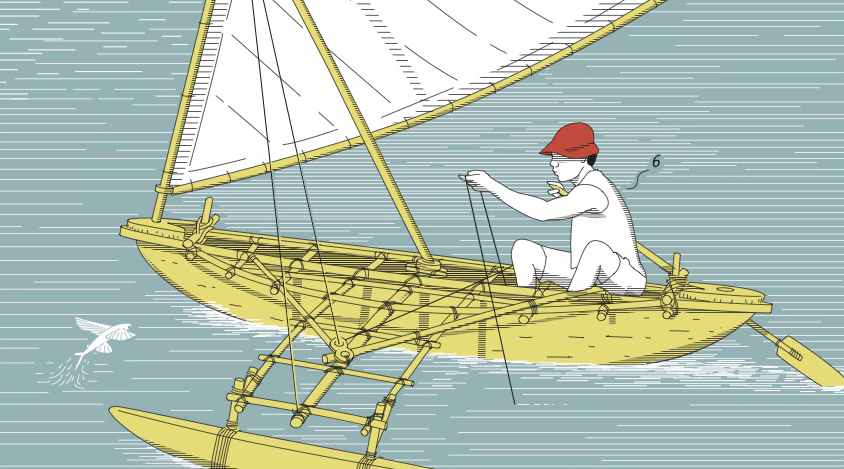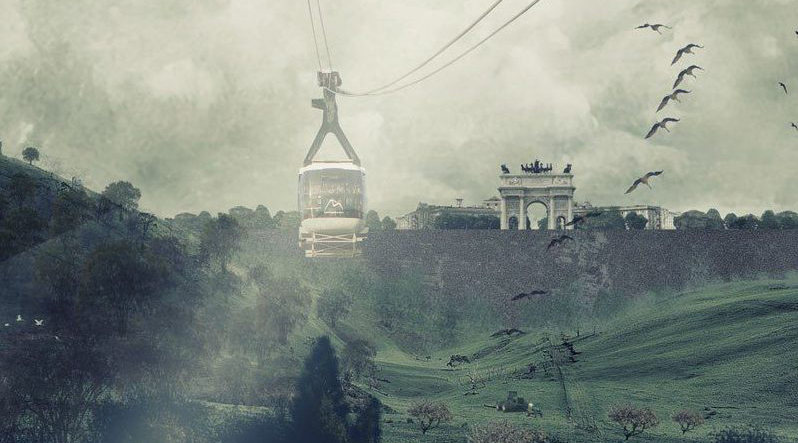EDITOR’S NOTE: Digital Earth offers a six-month fellowship for fifteen artists and designers based in Africa or Asia, working across a variety of media, who would like to investigate the intersection of technology with reality in our present day. The application deadline is August 19, 2018. More information can be found at http://thedigitalearth.org/

On January 1, 1998, at the California Science Center in Los Angeles, Al Gore presented his technological vision for a new future, which he called the Digital Earth—a virtual three-dimensional representation of Earth replete with vast quantities of embedded georeferenced data. The project would consist of a user interface built from various sources and geospatial datasets gathered through satellites images and photographs, integrated through software.
Gore described Digital Earth’s interface as a virtual spinning globe—a representation and a tool to work with all the data captured by a fleet of corporate and military satellites, airplanes, and sensors across and around the globe. This daring amount of information would be distributed among different computers around the world. Gore compared the project with the early ambitions of the Internet—the creation of a new system for the exchange of scientific knowledge and further human understanding of Planet Earth. The final aim of Digital Earth was to implement a new educational system with the planet as its central focus, in order to advance the earth sciences to address the most pressing problems of humanity.
Gore based his vision on Buckminster Fuller’s Geoscope 1962 proposal. Fuller envisioned Geoscope as a two-hundred-foot-diameter (sixty-one meter) globe made of glass and light bulbs, controlled by several electronic computers. Historical and contemporary data would be projected on the globe, and viewers would be able to experience the data flows by standing in the middle of the immersive installation and by looking around in all directions. Symbolically, the globe was to be installed adjacent to the UN headquarters in New York and be publicly accessible, representing humanity’s potential to know the planet and therefore to create a better future.1 Fuller’s aim was to create awareness among the public about humans’ place on the planet and their impact on the Earth’s geological system. As such, Geoscope was the product of a globalist political and cultural ideology that aimed to create a global history and spark imagination. In addition, Fuller also planned a series of smaller globes on which the orbital perspective of different hemispheres would be projected in order to present the public with different worldviews, literally.
In the paper “Cyber and Satellite Visualities: Analyzing the Digital Earth” (2000), Lisa Parks thoroughly analyzes Gore’s Digital Earth project and its political underpinnings through its visual rendering,2 its neoliberal and imperialist dimensions in particular. After all, such a project could only build on nearly forty years of US military and corporate developments in satellite technology and underground cable networks. The wealth of data needed to create this virtual globe could only be harvested by nonconsensual monitoring of foreign nations, a de facto invasion of their sovereign territory though the automated gaze of satellites. Moreover, Gore’s spinning globe would let users (or, as he put it, “children”) virtually wander around the earth to extract data and resources to construct a world based on Eurocentrism, cultural elitism, and sanitized history.”3
Gore’s utopian technological vision has never been fully realized. However, a very similar vision with similar ambitions of datafied omniscience came into being less than two decades ago: Google Earth and, later, Google Maps. The interface may be different, but the cultural and political ideologies are the same, and they influence our daily approach to space and geography.
In his book The Stack (2016), Benjamin Bratton lays out a relevant conceptual model through which to understand the current technological condition. The stack is a holistic scheme that connects the extraction of raw materials for the purpose of building hardware to Artificial Intelligence in the cloud.4 By emphasizing the importance of the earthly and material dimension of technological reality, Bratton adds a new layer to the Digital Earth project that might have been purposefully left out in Gore’s first conception. In fact, Bratton constantly stresses the links between, for instance, the algorithms for financial trading, Instagram feeds, the extraction of lithium in Chile, and the special economic zones in the Gulf. Together, these different material and immaterial layers form a coherent techno-political system—the stack, an accidental megastructure for planetary-scale computation.
In this newly envisioned Digital Earth, the technological megastructure is wrapping itself around the world with cables, data servers, mines, and oil platforms, while at the same time accelerating instant messaging apps and augmented-reality interfaces, and everything else that happens in cyberspace. It becomes clear, then, that the materiality and immateriality of our technological reality cannot be split, as the digital exists in both material and immaterial form at all times.
The dream of omniscience is more alive than ever. According to the World Economic Forum, the orbital and terrestrial sensorial apparatus humankind has created is harvesting such a monumental amount of data that it can be compared to the size of the planet itself.5 More precisely, human’s ability to map both above and below the surface of the Earth has accelerated at such speed that we can hypothetically have a digital twin of everything. Although this reality does not have a consistent and homogenous interface—it is by no means like Gore’s spinning globe, but it is rather composed of scattered interfaces across multiple devices—this digital double of the planet is nonetheless operational. As a matter of fact, the existence of a physical planet and its “datafied” counterpart generates a discrepancy between the reality on the ground and what is recorded and broadcasted—often leading to violent sociopolitical, economic, ecological, and cultural frictions.
When nature is so strongly entangled with and mediated via technology, how can we investigate, challenge, and unravel this condition?
Globally, designers and artists have already started investigating the new relations between technology and nature—among those is Femke Herregraven, a visual artist working on financial technology and infrastructure in relation to its material foundations. Her work Seismic Parallax (2017), for instance, is a salt-print diptych depicting two digital images that were made in the same week. On the left side is a print of the Whirlpool Galaxy at thirty million light-years away—the first image captured by the telescope in the recently opened Ethiopian space observatory. On the right is an infrared capture of a volcanic eruption in the Danakil Depression in Northern Ethiopia shot from outer space after Artificial Intelligence software, informed by a swarm of satellites, predicted and documented the event even before the geologists detected it. The two views, from below and above, crossing each other geographically, are mediated by advanced technology but printed with salt extracted from the Danakil Depression, materializing the abstract data sets in the geology of that very area.6

Another example is SEVER [SVR], a speculative design project created by Alexey Platonov, Francesco Sebregondi, Inna Pokazanyeva, and Ilda Iakubov at the Strelka Institute, in Moscow, aimed at protecting the Arctic Ocean through the creation of an Arctic-based cryptocurrency.7
As the ice of the Arctic is melting, a new ocean is emerging and with it, new financial opportunities. Countries like the United States, Canada, Denmark, and Russia are involved in a fierce geopolitical game of trade and sovereignty over the oil-rich waters. At the same time, NGOs are advocating to make the Arctic Ocean into a wildlife sanctuary. As a response, SEVER [SVR] proposes an alternative: the issuing of a cryptocurrency bound to the latitude of the Arctic, to thwart wealth extraction and the impoverishment of the communities living there. As soon as the tokens are transferred south, their economic value decreases exponentially. At the same time, the blockchain works as a register for each step in the production of goods in the automated factories and ports around the North Pole, making each unlawful polluting action virtually traceable, and its perpetrators accountable. In this way, a third option is opened between exploitation and preservation, creating a more sustainable solution.

Digital Earth supports design and artistic practices working on this technological condition in all media. In particular, it strongly supports practitioners from Africa and Asia, with a special focus on the new techno-cultural routes that connect diverse communities, states, and geozones. Digital Earth calls upon fifteen designers and artists to delve into different aspects of this multifarious, techno-natural entanglement, challenging it and bringing insights from their own practice and background.
1 R. Buckminster Fuller, Education Automation (Baden: Lars Muller Publishers, 2010).
2 Lisa Parks, “Cyber and Satellite Visualities: Analyzing the Digital Earth,” presented at Global Visual Cultures Conference, University of Wisconsin-Madison, November 10–12, 2000; and Gendering Cyberspace Conference, Odense, Denmark, November 24–26, 2000.
3 Lisa Parks, “Satellite and Cyber Visualities: Analyzing Digital Earth,” in The Visual Culture Reader, ed. Nicholas Mirzoeff (London: Routledge, 2002), p. 281.
4 Benjamin Bratton, The Stack: On Software and Sovereignty (Cambridge, MA: MIT Press, 2016).
5 “This Isn’t Sci-Fi: A Space-Based Sharing Economy Powered by Nano-Satellites Could Save Humanity,” World Economic Forum, https://www.weforum.org/agenda/2017/03/sharing-economy-space-blockchain/ (accessed July 19, 2018).
6 Femke Herregraven, http://femkeherregraven.net/seismic-parallax/ (accessed July 17, 2018).
7 SEVER, http://sever.network (accessed July 19, 2018).



